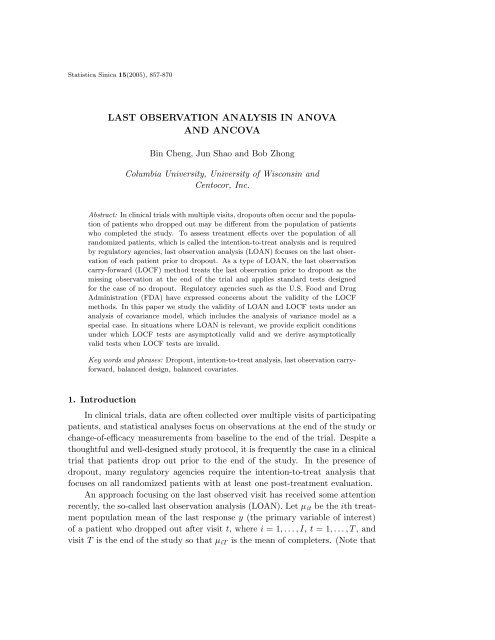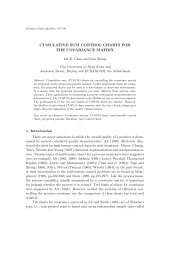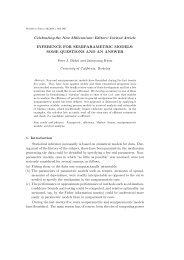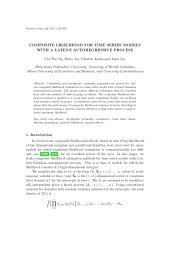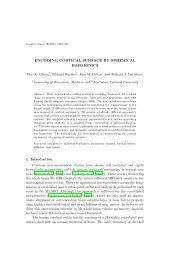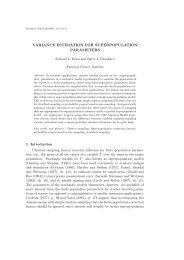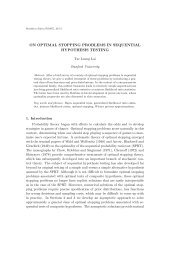last observation analysis in anova and ancova - Institute of Statistical ...
last observation analysis in anova and ancova - Institute of Statistical ...
last observation analysis in anova and ancova - Institute of Statistical ...
You also want an ePaper? Increase the reach of your titles
YUMPU automatically turns print PDFs into web optimized ePapers that Google loves.
860 BIN CHENG, JUN SHAO AND BOB ZHONG2. One-Way ANCOVAConsider a cl<strong>in</strong>ical trial consist<strong>in</strong>g <strong>of</strong> I treatments, n i patients r<strong>and</strong>omized totreatment group i, <strong>and</strong> T scheduled post-basel<strong>in</strong>e visits for each patient. Supposethat under treatment i, n it patients drop out after visit t. Hence, n i1 +· · ·+n iT =n i <strong>and</strong> (n i1 , . . . , n iT ) has the mult<strong>in</strong>omial(n i , p i1 , . . . , p iT ) distribution, where p itis the population proportion <strong>of</strong> patients dropp<strong>in</strong>g out after visit t under treatmenti. We assume a pattern-mixture one-way ANCOVA model, i.e., for patients whodrop out after visit t, their <strong>last</strong> observed responses y itk ’s are <strong>in</strong>dependent withmeans µ it + b ′ z itk , where k = 1, . . . , n it , t = 1, . . . , T , i = 1, . . . , I, the µ it ’sare unknown fixed treatment effects, z itk is a q-vector <strong>of</strong> covariates observed foreach patient, <strong>and</strong> b is a q-vector <strong>of</strong> unknown parameters. Unlike the y-responsevariable, the z-covariate for a patient does not vary with t, although we usethe notation z itk to specify it. No other condition is imposed on the dropoutmechanism (i.e., dropout may be nonignorable).When there is no dropout, test<strong>in</strong>g for treatment effect may be carried outby us<strong>in</strong>g responses from the end <strong>of</strong> the study <strong>and</strong> the method <strong>of</strong> ANCOVA.When there are dropouts, as we discussed <strong>in</strong> Section 1, the LOAN considers thehypothesisH 0 : µ 1 = · · · = µ I , (1)where µ i = p i1 µ i1 + · · · + p iT µ iT .The LOCF test is the ANCOVA test that treats y itk as the <strong>observation</strong> atthe end <strong>of</strong> the trial. S<strong>in</strong>ce µ it usually changes with t, one wonders what theLOCF tests for. If (1) is the hypothesis <strong>of</strong> <strong>in</strong>terest, there is the question <strong>of</strong>validity <strong>of</strong> the LOCF test. The follow<strong>in</strong>g result shows when the LOCF test isasymptotically valid for (1). S<strong>in</strong>ce Shao <strong>and</strong> Zhong (2003) showed that whenI ≥ 3, the LOCF test is asymptotically wrong for test<strong>in</strong>g (1) <strong>in</strong> a one-wayANOVA without covariates, we only consider the case <strong>of</strong> I = 2 treatments.In this paper, χ 2 ddenotes the chi-square distribution with d degree <strong>of</strong> freedom,while χ 2 d,α <strong>and</strong> F l,m,α denote, respectively, the 1 − α quantiles <strong>of</strong> χ 2 d<strong>and</strong> the F-distribution with degrees <strong>of</strong> freedom l <strong>and</strong> m, where α is a given nom<strong>in</strong>al level.Let[MSTR = (ȳ 1.. − ˆb ′¯z 1.. ) − (ȳ 2.. − ˆb ′¯z ] / 2 2∑ T∑ ∑n it2.. )a 2 itk ,i=1 t=1 k=112∑ T∑ ∑n it [MSE =(y itk − ȳ i.. ) −n 1 + n 2 − q − 2ˆb ′ 2(z itk − ¯z i.. )],i=1 t=1 k=1where z itk is the covariate value associated with y itk , ȳ i.. <strong>and</strong> ¯z i.. are, respectively,the averages <strong>of</strong> y itk <strong>and</strong> z itk over the <strong>in</strong>dexes t <strong>and</strong> k,2∑ T∑ˆb = (˜Z ′ ∑n it−1 ˜Z) (y itk − ȳ i.. )(z itk − ¯z i.. ),i=1 t=1 k=1
862 BIN CHENG, JUN SHAO AND BOB ZHONGThat is, the LOCF test is asymptotically valid for test<strong>in</strong>g (1) when (6) or (7)holds. Note that Shao <strong>and</strong> Zhong (2003) showed that the condition lim(n 1 /n 2 ) =1 ensures the asymptotic validity <strong>of</strong> the LOCF test <strong>in</strong> one-way ANOVA. Whenthere are covariates, our result shows that <strong>in</strong> addition to the balance conditionlim n 1 /n 2 = 1, the validity <strong>of</strong> the LOCF test requires the covariates to be balanced<strong>in</strong> the sense that either the means <strong>of</strong> the covariates under two treatmentsare asymptotically the same (condition (6)) or the covariance matrices <strong>of</strong> thecovariates under two treatments are asymptotically the same (condition (7)).When there are I ≥ 3 treatments or the design is not balanced, the LOCFtest has the wrong asymptotic size for test<strong>in</strong>g (1). An asymptotically valid test <strong>of</strong>(1) is derived as follows. For the ith treatment, let ˆb i =(˜Z ′ ˜Z i i ) −1∑ T∑ nitt=1 k=1 z itky itk ,where ˜Z i is the n i ×q matrix whose n i rows are z ′ i11 −¯z′ i.. , . . . , z′ i1n i1−¯z ′ i.. , ...., z′ iT n iT−¯z ′ i.. , <strong>and</strong> let u itk = y itk − ˆb ′ i z itk. Then ū i.. = n −1 ∑ T∑ niti t=1 k=1 u itk is unbiased forµ i <strong>and</strong> asymptotically normal, <strong>and</strong> its variance can be estimated consistently byˆV i =1n i (n i − 1)T∑ ∑n it(u itk − ū i.. ) 2 .t=1 k=1Theorem 2. Suppose that, for patients dropp<strong>in</strong>g out after visit t, the y itk ’s are<strong>in</strong>dependent with means µ it +b ′ z itk <strong>and</strong> variances σ 2 it > 0. Under (1), as n i → ∞for all i, W → d χ 2 I−1 , whereW =I∑i=1( ∑1Ii=1ū i.. −ūi../ ˆV) 2i∑ˆV Ii i=1 1/ ˆV.iConsequently, an asymptotic size α test rejects (1) if <strong>and</strong> only if W > χ 2 I−1,α .Note that we do not assume the variances <strong>of</strong> y itk ’s are equal <strong>in</strong> Theorem 2.When (1) is rejected, we can make <strong>in</strong>ference (such as pairwise or multiplecomparison on µ i ’s) us<strong>in</strong>g the asymptotic results based on ū i.. <strong>and</strong> ˆV i .3. Tests for Interaction <strong>in</strong> Two-Way ModelsTwo-way ANOVA or ANCOVA is <strong>of</strong>ten used <strong>in</strong> cl<strong>in</strong>ical trials. In additionto the treatment effect, a common factor <strong>in</strong> a two way ANOVA or ANCOVA isthe center effect <strong>in</strong> a multicenter trial. Consider a cl<strong>in</strong>ical trial carried out <strong>in</strong>J centers with I treatments, n ij patients r<strong>and</strong>omized to treatment group i atcenter j, <strong>and</strong> T scheduled visits for each patient. The total number <strong>of</strong> patientsis n = ∑ I ∑ Ji=1 j=1 n ij. Suppose that under treatment i at center j, n ijt patientsdrop out after visit t. Then (n ij1 , . . . , n ijT ) has the mult<strong>in</strong>omial(n ij , p ij1 , ..., p ijT )distribution, where p ijt is the population proportion <strong>of</strong> patients dropp<strong>in</strong>g outafter visit t under treatment i at center j. Let y ijtk be the <strong>last</strong> observed response
LAST OBSERVATION ANALYSIS IN ANOVA AND ANCOVA 863variable <strong>of</strong> <strong>in</strong>terest from patient k under treatment i at center j who droppedout after the tth visit.Under the two-way ANOVA model, for patients dropp<strong>in</strong>g out after visit t,we assume that y ijtk ’s are <strong>in</strong>dependent with means µ ijt . Similar to the one-waycase, we use theT∑µ ij = p ijt µ ijt (8)t=1as measures for treatment <strong>and</strong> center effects. Under two-way models, the µ i <strong>and</strong>µ it <strong>of</strong> previous sections should be replaced by µ ij <strong>and</strong> µ ijt , respectively. Considerthe decompositionµ ij = µ + α i + β j + γ ij ,where µ is an overall mean, α i ’s are fixed treatment effects (α 1 +· · ·+α I = 0), β j ’sare fixed center effects (β 1 + · · · + β J = 0), <strong>and</strong> γ ij ’s are fixed <strong>in</strong>teraction effects(γ i1 + · · · + γ iJ = γ 1j + · · · + γ Ij = 0 for any i <strong>and</strong> j). Although the treatmenteffects α i ’s are <strong>of</strong> primary <strong>in</strong>terest, the <strong>analysis</strong> <strong>in</strong> two-way ANOVA <strong>of</strong>ten startswith a test for the treatment-by-center <strong>in</strong>teraction with the null hypothesisH 0 : γ ij = 0, for all i <strong>and</strong> j. (9)To test (9), the LOCF test treats y ijtk as the <strong>observation</strong> <strong>in</strong> the end <strong>of</strong> the trial<strong>and</strong> rejects H 0 when MSAB/MSE > F (I−1)(J−1),n−IJ,α , whereMSAB =MSE =1(I − 1)(J − 1) ȳ′ L(L ′ ΛL) −1 L ′ ȳ,1n − IJI∑J∑i=1 j=1 t=1 k=1n T∑ ∑ ijt(y ijtk − ȳ ij.. ) 2 ,ȳ ij.. is the average <strong>of</strong> y ijtk ’s over t <strong>and</strong> k, ȳ = (ȳ 11.. , . . . , ȳ I1.. , . . . , ȳ 1J.. , . . . , ȳ IJ.. ) ′ ,Λ = diag(n −111 , . . . , n−1 I1, ..., n−11J , . . . , n−1 IJ ),( ) ( )1 ′L =(J−1)1 ′⊗(I−1),−I (J−1) −I (I−1)1 m is the m-vector <strong>of</strong> ones, I m is the identity matrix <strong>of</strong> order m, <strong>and</strong> ⊗ is theKronecker product. The follow<strong>in</strong>g result shows what this tests for, <strong>and</strong> when itis asymptotically valid. The pro<strong>of</strong> can be found <strong>in</strong> Cheng (2004).Theorem 3. Assume that, for patients dropp<strong>in</strong>g out after visit t, y ijtk ’s are<strong>in</strong>dependent with means µ ijt <strong>and</strong> variance σ 2 > 0.
864 BIN CHENG, JUN SHAO AND BOB ZHONG(i) As n ij → ∞ for all i, j, MSE → p σ 2 + η, whereη = lim 1 nI∑i=1 j=1J∑n ij τij 2 <strong>and</strong> τij 2 =T∑p ijt (µ ijt − µ ij ) 2 .(ii) Under (9), MSAB converges <strong>in</strong> distribution to a l<strong>in</strong>ear comb<strong>in</strong>ation <strong>of</strong> (I −1)(J − 1) <strong>in</strong>dependent chi-square r<strong>and</strong>om variables with 1 degree <strong>of</strong> freedom.The LOCF test for <strong>in</strong>teraction is asymptotically valid (i.e., MSAB/MSE isasymptotically distributed as χ 2 (I−1)(J−1)) if <strong>and</strong> only ift=1L ′ VL = ηL ′ ΛL, (10)where V = diag(n −111 τ 11 2 , . . . , n−1 I1 τ I1 2 , . . . , n−1 1J τ 1J 2 , . . . , n−1 IJ τ IJ 2 ).(iii) When I = J = 2, (10) becomes∑ 2 ∑ 2i=1 j=1limn ijτij2 ∑ 2∑ 2i=1 j=1∑ 2 ∑ 2i=1 j=1 n = limn−1 ij τ ij2∑ 2 ∑ 2. (11)iji=1 j=1 n−1 ijWhen I = 2 <strong>and</strong> J ≥ 3, (10) becomesn −11j τ 2 1j + n−1 2j τ 2 2jn −11j+ n−1 2j=∑ Jj=1 n ijτij2∑ 2∑ Ji=1 j=1 n , for all j. (12)ij∑ 2i=1When I ≥ 3 <strong>and</strong> J = 2, (10) becomesn −1i1 τ 2 i1 + n−1 i2 τ 2 i2n −1i1+ n−1 i2=∑ Ii=1∑ 2j=1 n ijτij2∑ I ∑ 2i=1 j=1 n , for all i. (13)ijWhen I ≥ 3 <strong>and</strong> J ≥ 3, (10) becomesτ 2 ij = constant. (14)When I = J = 2 <strong>and</strong> µ ijt ’s are different for given i <strong>and</strong> j (so that the τ ij ’s aredifferent), (11) implies that the LOCF test for treatment-by-center <strong>in</strong>teractionis asymptotically valid for test<strong>in</strong>g (9) if the design is balanced <strong>in</strong> the sense thatlim n ij /n = 1/4 for any i <strong>and</strong> j. Although <strong>in</strong> many applications the number<strong>of</strong> treatments I = 2, the number <strong>of</strong> centers J is <strong>of</strong>ten more than 2. From(12) through (14), we know that when either I or J is more than 2, the onlypractical situation that a LOCF procedure is valid is when the τij 2 are all thesame or, equivalently, the µ ijt ’s are the same for fixed i <strong>and</strong> j. A result similarto Theorem 3 for a two-way ANCOVA model can be derived, but it is omitteds<strong>in</strong>ce a necessary condition for the validity <strong>of</strong> the LOCF test is I = J = 2, whichis a limited special case.
LAST OBSERVATION ANALYSIS IN ANOVA AND ANCOVA 865An asymptotically valid test for (9) can be derived based on cell mean estimatorsȳ ij.. <strong>and</strong> their consistent variance estimators. We now consider the generaltwo-way ANCOVA model (which <strong>in</strong>cludes the ANOVA model as a special case)<strong>in</strong> which the mean <strong>of</strong> y ijtk (for patients dropp<strong>in</strong>g out after visit t) isµ ijt + b ′ z ijtk , (15)where z ijtk is a q-vector <strong>of</strong> covariates observed for each patient, <strong>and</strong> b is a q-vector<strong>of</strong> unknown parameters. For any i <strong>and</strong> j, let ˆb ij be the least squares estimator<strong>of</strong> b based on the data from the patients who received the ith treatment <strong>in</strong> the∑ Tt=1∑ nijtk=1 u ijtk is anjth center <strong>and</strong> let u ijtk = y ijtk − ˆb ′ ij z ijtk. Then ū ij.. = n −1ijunbiased <strong>and</strong> asymptotically normal estimator <strong>of</strong> µ ij with a consistent varianceestimatorˆV ij =1n ij (n ij − 1)n T∑ ∑ ijt(u ijtk − ū ij.. ) 2 .t=1 k=1Theorem 4. Suppose that, for patients dropp<strong>in</strong>g out after visit t, the y ijtk ’sare <strong>in</strong>dependent with means given by (15) <strong>and</strong> variances σijt 2 . Under (9), asn ij → ∞ for all i, j, W → d χ 2 (I−1)(J−1) , where W = ū′ L(L ′ ˆVL) −1 L ′ ū, ˆV =diag( ˆV 11 , . . . , ˆV I1 , . . . , ˆV 1J , . . . , ˆV IJ ), <strong>and</strong> ū=(ū 11.. , . . . , ū I1.. , . . . , ū 1J.. , . . . , ū IJ.. ) ′ .Consequently, a test <strong>of</strong> (9) with asymptotic size α rejects H 0 if W >χ 2 (I−1)(J−1),α. It is clear that the result <strong>in</strong> Theorem 4 can be extended to K-wayANCOVA models.4. Additive Two-Way ANCOVAIn a multicenter cl<strong>in</strong>ical trial, treatment-by-center <strong>in</strong>teraction can sometimesbe ignored, especially when covariates related to centers are <strong>in</strong>troduced <strong>in</strong>to themodel. Hence, <strong>in</strong> this section we consider an additive two-way ANCOVA model,which <strong>in</strong>cludes the additive two-way ANOVA model as a special case.Consider the multicenter cl<strong>in</strong>ical trial described <strong>in</strong> Section 3, where the mean<strong>of</strong> y ijtk for patients dropp<strong>in</strong>g out after visit t is µ ijt + b ′ z ijtk , z ijtk is a q-vector <strong>of</strong>covariates observed from every patient, <strong>and</strong> b is a q-vector <strong>of</strong> unknown parameters.Let µ ij be given by (8) <strong>and</strong> assume the additive modelµ ij = µ + α i + β j , (16)where µ is an overall mean, α i ’s are fixed treatment effects (α 1 + · · · + α I = 0),<strong>and</strong> β j ’s are fixed center effects (β 1 + · · · + β J = 0). The null hypothesis <strong>of</strong> notreatment effect isH 0 : α 1 = · · · = α I = 0. (17)
866 BIN CHENG, JUN SHAO AND BOB ZHONGThe LOCF procedure for test<strong>in</strong>g (17) treats µ ijt as µ ijT for all t <strong>and</strong> uses thefollow<strong>in</strong>g model E(Y) = Xθ + Zb, where θ = (µ, α 1 , . . . , α I , β 1 , . . . , β J ) ′ , Y isthe column vector formed by list<strong>in</strong>g the elements y ijtk <strong>in</strong> the order <strong>of</strong> i, j, t <strong>and</strong>k, Z is the matrix formed by list<strong>in</strong>g the row vectors z ijtk <strong>in</strong> the order <strong>of</strong> i, j, t<strong>and</strong> k, <strong>and</strong> X is the usual design matrix <strong>in</strong> a two-way additive ANOVA model.Def<strong>in</strong>e P = I − X(X ′ X) − X ′ <strong>and</strong>ˆb = (Z ′ PZ) −1 Z ′ PY. (18)The follow<strong>in</strong>g theorem shows when the LOCF test is asymptotically validfor test<strong>in</strong>g (17). Its pro<strong>of</strong> is similar to that <strong>of</strong> Theorem 1 <strong>and</strong> is omitted. First,let( n 2∑ J∑ T∑ ijtn∑J∑ T∑ ∑ ijtMSTR =a 2 ijtk ,i=1 j=1 t=1k=1a ijtk y ijtk) 2/ 2∑i=1j=1 t=1 k=1where the a ijtk ’s are the components <strong>of</strong> the vector that is the difference betweenthe second <strong>and</strong> the third rows <strong>of</strong> (X ′ X) − X ′ (I − Z(Z ′ PZ) −1 Z ′ P), <strong>and</strong>MSE =1n − (2J + q)2∑J∑i=1 j=1 t=1 k=1n T∑ ∑ ijt [(y ijtk − ȳ ij.. ) − ˆb ′ 2(z ijtk − ¯z ij.. )],where ȳ ij.. <strong>and</strong> ¯z ij.. are averages <strong>of</strong> y ijtk <strong>and</strong> z ijtk over <strong>in</strong>dices t <strong>and</strong> k, respectively.Theorem 5. Assume that I = 2 <strong>and</strong>, for patients dropp<strong>in</strong>g out after visit t, they ijtk ’s are <strong>in</strong>dependent with means µ ijt + b ′ z ijtk <strong>and</strong> variance σ 2 > 0, <strong>and</strong> theµ ij ’s have form given <strong>in</strong> (16).(i) The ANCOVA test based on LOCF rejects hypothesis (17) when the ratioF =MSTR/MSE is larger than F 1,n−2J−q,α .(ii) As n ij → ∞, i = 1, 2 <strong>and</strong> j = 1, . . . , J, MSE → p σ 2 + η, whereη = lim∑ 2∑ Ji=1 j=1 n ijτij2∑ 2 ∑ Ji=1 j=1 n ij, τ 2 ij =T∑p ijt (µ ijt − µ ij ) 2 . (19)(iii) Under (17), as n ij → ∞, i = 1, 2 <strong>and</strong> j = 1, . . . , J, MSTR → d (σ 2 + ζ)χ 2 1 ,where∑ 2 ∑ Ji=1 j=1ζ = limw ijτij2 n T∑ ∑ ijt∑ 2∑ Ji=1 j=1 w , w ij = a 2 ijtk . (20)ijt=1t=1 k=1(iv) For test<strong>in</strong>g hypothesis (17), the LOCF procedure described <strong>in</strong> (i) is asymptoticallyvalid if <strong>and</strong> only iflim∑ 2i=1∑ Jj=1 n ijτ 2 ij∑ 2 ∑ Ji=1 j=1 n ij= lim∑ 2 ∑ Ji=1 j=1 w ijτij2∑ 2 ∑ Ji=1 j=1 w . (21)ij
LAST OBSERVATION ANALYSIS IN ANOVA AND ANCOVA 867When the design is balanced, i.e., n ij = n 0 for all i, j, (21) can be simplified.Corollary 1. Assume the conditions <strong>in</strong> Theorem 5 <strong>and</strong> n ij = n 0 for all i, j. Let˜Z be the (IJn 0 ) × q matrix whose rows are z ′ ijtk − ¯z′ i... − ¯z′ .j.. + ¯z′ ..... Thenw ij = (Jn 0 ) −1 + (¯z 1... − ¯z 2... ) ′ (˜Z ′ ˜Z) −1 S ij (˜Z ′ ˜Z) −1 (¯z 1... − ¯z 2... ),∑ nijtwhere S ij = ∑ Tt=1 k=1 (z ijtk − ¯z i... − ¯z .j.. + ¯z .... ) (z ijtk − ¯z i... − ¯z .j.. + ¯z .... ) ′ , <strong>and</strong>(21) holds if <strong>and</strong> only if lim ¯z 1... = lim ¯z 2... or lim n −10 S ij are the same for all i<strong>and</strong> j.When (21) does not hold, the LOCF procedure described <strong>in</strong> Theorem 5(i)is no longer valid for test<strong>in</strong>g (17). To derive a general valid test for (17), forany fixed i , let ˆb i be the estimator <strong>of</strong> b based only on the data from thepatients who received the ith treatment by a formula similar to (18). Def<strong>in</strong>eu ijtk = y ijtk − ˆb ′ i z ijtk. Then ū i... = 1 ∑ J ∑ T ∑ nijtn i j=1 t=1 k=1 u ijtk is an unbiased <strong>and</strong>asymptotically normal estimator for µ + α i <strong>and</strong> its variance can be estimatedconsistently byn1J∑ T∑ ∑ ijtˆV i =(u ijtk − ū i... ) 2 .n i (n i − 1)j=1 t=1 k=1Theorem 6. Suppose that, conditional on (n ij1 , . . . , n ijT ), the y ijtk ’s are <strong>in</strong>dependentwith means µ ijt + b ′ z ijtk <strong>and</strong> variances σijt 2 , <strong>and</strong> the µ ij’s have the decompositiongiven <strong>in</strong> (16). Under (17), as n ij → ∞ for all i <strong>and</strong> j, W → d χ 2 I−1 ,where(I∑∑1Ii=1W = ū i... −ūi.../ ˆV) 2i∑ˆV Ii i=1 1/ ˆV.ii=1Consequently, a test <strong>of</strong> (17) with asymptotic size α rejects H 0 if W > χ 2 I−1,α .Inference about α i ’s after (17) is rejected can be made us<strong>in</strong>g the asymptoticresults based on ū i... <strong>and</strong> ˆV i .The results <strong>in</strong> Theorems 5 <strong>and</strong> 6 can be extended to K-way additive AN-COVA models with K ≥ 3. We provide a brief discussion here <strong>and</strong> omit thedetails. Under any K-way additive ANCOVA model, the LOCF test for the effect<strong>of</strong> a factor with two levels is asymptotically valid if the design is balanced,<strong>and</strong> either the covariate averages under the two levels are the same, or the covariatevariability across different cells (comb<strong>in</strong>ations <strong>of</strong> factors) is constant. Inany case, asymptotically valid tests can be derived along the l<strong>in</strong>es <strong>of</strong> Theorem 6.5. Simulation ResultsA simulation study was performed to study the f<strong>in</strong>ite-sample type I error <strong>of</strong>the LOCF test <strong>and</strong> the proposed test <strong>in</strong> Theorem 6 <strong>in</strong> an ANCOVA model. The
868 BIN CHENG, JUN SHAO AND BOB ZHONGsample sizes <strong>and</strong> population parameters were chosen to be similar to a phase IIcl<strong>in</strong>ical trial <strong>in</strong> a real application with I = 2 treatments, J = 3 centers, <strong>and</strong> T = 3visits. Responses y ijtk ’s were generated by the follow<strong>in</strong>g steps. All parametervalues are given <strong>in</strong> Table 1.Table 1. Population parameters <strong>in</strong> the simulation.i, j p ij1 , p ij2 , p ij3 µ ij1 , µ ij2 , µ ij3 σ ij1 , σ ij2 , σ ij31, 1 0.30, 0.20, 0.50 −11656.40, −11668.30, −11804.53 251.2, 249.7, 348.71, 2 0.36, 0.36, 0.28 −11682.40, −11660.80, −11758.14 396.1, 131.3, 258.01, 3 0.08, 0.33, 0.59 −12012.36, −11650.40, −11434.70 143.8, 143.8, 591.92, 1 0.33, 0.07, 0.60 −11705.31, −10473.82, −11905.71 510.4, 486.2, 486.22, 2 0.18, 0.27, 0.55 −12160.21, −11500.81, −11637.39 371.7, 807.8, 831.52, 3 0.18, 0.18, 0.64 −11767.81, −10762.31, −11720.27 501.4, 311.6, 716.71. Generate covariates z 1jtk ’s as a r<strong>and</strong>om sample <strong>of</strong> size n 1 = n 11 +n 12 +n 13 fromN(846.6, 514.1 2 ), <strong>and</strong> z 2jtk ’s as a r<strong>and</strong>om sample <strong>of</strong> size n 2 = n 21 + n 22 + n 23from N(845.2, 367.7 2 ).2. For each fixed i <strong>and</strong> j, generate (n ij1 , n ij2 , n ij3 ) from Mult<strong>in</strong>omial (n ij , p ij1 ,p ij2 , p ij3 ).3. For each fixed i, j, <strong>and</strong> t, generate y ijtk ’s as a r<strong>and</strong>om sample <strong>of</strong> size n ijt fromN(µ ijt + bz ijtk , σijt 2 ), where b = 14.7.Note that the means <strong>of</strong> y ijtk ’s were chosen so that µ 1j = µ 2j for all j,which implies that the model is additive with no treatment effect, that is, (17)is true. The actual type I errors <strong>of</strong> the LOCF test <strong>and</strong> the proposed test wereevaluated by simulation with 5,000 runs. Results with different choices <strong>of</strong> n ij ’sare summarized <strong>in</strong> Table 2. The results <strong>in</strong>dicate that the proposed test has sizeclose to the nom<strong>in</strong>al level 5% regardless <strong>of</strong> whether the sample sizes are balancedor not. The results also show that the LOCF test has the right size when thesample sizes are almost balanced, but a wrong size when the sample sizes areunbalanced. These simulation results generally support our asymptotic results.Table 2. Type I errors <strong>of</strong> the LOCF <strong>and</strong> proposed tests.Sample SizeType I Errorn 11 , n 12 , n 13 n 21 , n 22 , n 23 LOCF Test Proposed Test30, 33, 36 27, 33, 33 0.0548 0.054460, 66, 72 27, 33, 33 0.1118 0.052015, 17, 18 27, 33, 33 0.0170 0.051830, 33, 36 54, 66, 66 0.0170 0.049630, 33, 36 14, 17, 17 0.1078 0.0576
LAST OBSERVATION ANALYSIS IN ANOVA AND ANCOVA 869AppendixPro<strong>of</strong> <strong>of</strong> Theorem 1.(ii) Let u itk = y itk − b ′ z itk . The result follows from Lemma 1 <strong>of</strong> Shao <strong>and</strong> Zhong(2003) <strong>and</strong> the fact thatMSE ==(iii) Note that1n 1 + n 2 − q − 21n 1 + n 2 − q − 22∑T∑ ∑n it [] 2(u itk − ū i.. ) − (ˆb − b) ′ (z itk − ¯z i.. )i=1 t=1 k=1n it2∑T∑ ∑(u itk − ū i.. ) 2 + o p (1).i=1 t=1 k=1(ȳ 1.. − ˆb ′¯z 1.. ) − (ȳ 2.. − ˆb ′¯z 2.. ) =T∑ ∑n 1ta 1tk y 1tk −t=1 k=1T∑ ∑n 2ta 2tk y 2tk .t=1 k=1By an argument similar to that <strong>of</strong> Theorem 1 <strong>of</strong> Shao <strong>and</strong> Zhong (2003) <strong>and</strong>Theorem 3.12 <strong>of</strong> Shao (2003), we have[(ȳ 1.. − ˆb ′¯z 1.. ) − (ȳ 2.. − b ′¯z ] /√ √ √√ ( 2∑2.. )∑ nitT∑ ∑n iti=1 t=1 k=1a 2 itk)σ 2 + φ 2 1 + φ2 1 → d N(0, 1),where φ 2 i = Var( ∑ Tt=1 k=1 a itk(µ it + b ′ z itk )). Then the result follows if φ 2 i =τi 2w2 i holds for i = 1, 2. We only prove the case when i = 1 as an illustration.S<strong>in</strong>ce the covariate value <strong>of</strong> a patient does not vary with visit, we can rewrite z itkas z ij <strong>and</strong> a itk as a ij , where j = 1, . . . , n 1 . For t = 1, . . . , T , let X 1jt = 1 if <strong>and</strong>only if a 1j is from a patient who dropped out after the tth visit, <strong>and</strong> X 1jt = 0otherwise. Clearly, X 1j = (X 1j1 , . . . , X 1jT ) i.i.d. ∼ Mult<strong>in</strong>omial(1; p 11 , . . . , p 1T ), j =1, . . . , n 1 . Hence( T∑n 1φ 2 1 = Var ∑)a 1j (µ 1t + b ′ z 1j )X 1jtt=1 j=1( ∑n 1 ( ∑T= Var a 1j µ 1t X 1jt +j=1( ∑n 1= Var( ∑n 1= Vart=1∑Ta 1jj=1 t=1∑Ta 1jj=1 t=1T∑ ))b ′ z 1j X 1jtt=1∑n 1 )µ 1t X 1jt + a 1j b ′ z 1jµ 1t X 1jt)j=1
870 BIN CHENG, JUN SHAO AND BOB ZHONG∑n 1 ( ∑T )= a 2 1jVar µ 1t X 1jtj=1= τ 2 1Acknowledgements∑n 1j=1t=1a 2 1j = τ 2 1T∑ ∑n 1sa 2 1tk = τ 1 2 w2 1 .t=1 k=1This work was partially supported by grant CA53786 from the NationalCancer <strong>Institute</strong>. The authors would like to thank two referees <strong>and</strong> an associateeditor for their helpful comments.ReferencesCheng, B. (2004). Some hypothesis test<strong>in</strong>g results <strong>in</strong> two-way l<strong>in</strong>ear models for cl<strong>in</strong>ical trials.Ph.D. thesis, University <strong>of</strong> Wiscons<strong>in</strong>-Madison.Dawson, J. D. (1994a). Compar<strong>in</strong>g treatment groups on the basis <strong>of</strong> slopes, areas-under-thecurve,<strong>and</strong> other summary measures. Drug Infor. J. 28, 723-732.Dawson, J. D. (1994b). Stratification <strong>of</strong> summary statistic tests accord<strong>in</strong>g to miss<strong>in</strong>g patterns.Statist. Medic<strong>in</strong>e 13, 1853-1863.Dawson, J. D. <strong>and</strong> Lagakos, S. W. (1993). Size <strong>and</strong> power <strong>of</strong> two-sample tests <strong>of</strong> repeatedmeasures data. Biometrics 49, 1022-1032.FDA (1988). Guidel<strong>in</strong>e for Format <strong>and</strong> Content <strong>of</strong> the Cl<strong>in</strong>ical <strong>and</strong> <strong>Statistical</strong> Sections <strong>of</strong> NewDrug Applications. Center for Drug Evaluation <strong>and</strong> Research, Food <strong>and</strong> Drug Adm<strong>in</strong>istration,Rockville, Maryl<strong>and</strong>.Heyt<strong>in</strong>g, A. <strong>and</strong> Tolboom, J. T. B. M. <strong>and</strong> Essers, J. G. A. (1992). <strong>Statistical</strong> h<strong>and</strong>l<strong>in</strong>g <strong>of</strong>drop-outs <strong>in</strong> longitud<strong>in</strong>al cl<strong>in</strong>ical trials. Statist. Medic<strong>in</strong>e 11, 2043-2061.Lavori, P. W. (1992). Cl<strong>in</strong>ical trials <strong>in</strong> psychiatry: Should protocol deviation censor patientdata? Neuropsychopharmacology 6, 39-48.Little, R. (1993). Pattern-Mixure Models for Multivariate Incomplete Data. J. Amer. Statist.Assoc. 88, 125-134.Searle, S. R. (1987). L<strong>in</strong>ear Models for Unbalanced Data. Wiley, New York.Shao, J. (2003). Mathematical Statistics. Second edition. Spr<strong>in</strong>ger-Verlag, New York.Shao, J. <strong>and</strong> Zhong, B. (2003). Last Observation Carry-Forward <strong>and</strong> Last Observation Analysis.Statist. Medic<strong>in</strong>e 22, 2429-2441.Shih, W. <strong>and</strong> Quan, H. (1998). Stratified test<strong>in</strong>g for treatment effects with miss<strong>in</strong>g data.Biometrics 54, 782-787.T<strong>in</strong>g, N. (2000). Carry-forward <strong>analysis</strong>. In Encyclopedia <strong>of</strong> Biopharmaceutical Statistics(Edited by S. Chow), 103-109. Marcel Dekker, New York.Department <strong>of</strong> Biostatistics, Mailman School <strong>of</strong> Public Health, Columbia University, New York,NY 10032, U.S.A.E-mail: bc2159@columbia.eduDepartment <strong>of</strong> Statistics, University <strong>of</strong> Wiscons<strong>in</strong>, Madison, WI 53706, U.S.A.E-mail: shao@stat.wisc.eduCentocor, Inc., Malvern, PA 19355, U.S.A.E-mail: BZhong@CNTUS.JNJ.COM(Received December 2003; accepted November 2004)


